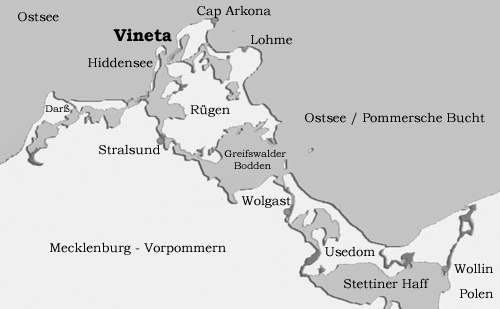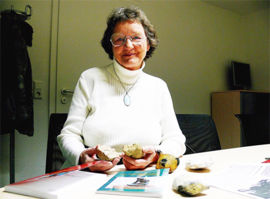Vineta
Goldmann, Klaus
 Klaus Goldmann (1936-2019) was a German archaeologist, who before retiring was senior curator at Berlin’s Museum of Pre- and Early History. Atlantisforschung reported that “Dr Goldmann also dealt with the controversial interpretations of the Atlantis legend. Privately it was known that he largely represented the views of the Bordelum pastor and private researcher Jürgen Spanuth. Officially, however, his superiors gave him to understand that he was not allowed to represent this opinion in public.”(a)
Klaus Goldmann (1936-2019) was a German archaeologist, who before retiring was senior curator at Berlin’s Museum of Pre- and Early History. Atlantisforschung reported that “Dr Goldmann also dealt with the controversial interpretations of the Atlantis legend. Privately it was known that he largely represented the views of the Bordelum pastor and private researcher Jürgen Spanuth. Officially, however, his superiors gave him to understand that he was not allowed to represent this opinion in public.”(a)
The journal Archaeology recorded that Dr. Goodmann engaged in a search for the lost Baltic city of Vineta “along with economist and journalist Günter Wermusch and in collaboration with the Hamburg Technical University, he is seeking to pinpoint the location of the lost city(b). For that, Goldmann is relying on medieval documents and maps and modern aerial and satellite photographs.” I should point out that Vineta was nominated as the location of Atlantis by Doris Manner.
(b) https://archive.archaeology.org/0307/abstracts/letter.html.
Vineta
Vineta was a legendary city on the Baltic in what is now the German state of Mecklenburg-Western Pomerania. The city was destroyed when it sank into the sea and thought by some to be the source of the Atlantis story. It is reputed to have existed near the north German city of Barth.
 It was considered to be the most important trading city in Europe with links as far as the Mediterranean. The Arabic writer Ibrahim Ibn Yaqub described it (c. 970) as “a large city by the ocean with twelve gates, the greatest of all cities in Europe, farthest north-west in the country of Misiko (Poland) in the marshes by the ocean”.(a)
It was considered to be the most important trading city in Europe with links as far as the Mediterranean. The Arabic writer Ibrahim Ibn Yaqub described it (c. 970) as “a large city by the ocean with twelve gates, the greatest of all cities in Europe, farthest north-west in the country of Misiko (Poland) in the marshes by the ocean”.(a)
Doris Manner has written a book[466] on the subject and also has a website(b), which is available in German and English. She courageously identifies Atlantis with Vineta, Titans with Teutons and Vineta, in the past referred to as Niniveta, with the Nineveh of the Bible.
A more conventional history of the lost Baltic city is offered by Ingrid & P. Werner Lange in their Vineta, Atlantis des Nordens (Vineta: Atlantis of the North)[1125].. Two other German researchers who are also on the trail of Vineta, are Dr. Klaus Goldmann (Vineta: Die Wiederentdeckung einer versunkenen Stadt) and Günter Wermusch (Das Vineta Rätsel)
The excellent German website, Atlantisforschung.de, offers further information about Manner’s work.(d)
(a) See: https://web.archive.org/web/20120204201941/https://marebalticum.natmus.dk/vinetaUK.asp?ID=29
(b) https://www.atlantis-niniveta.de/
(d) https://atlantisforschung.de/index.php?title=Atlantis_lag_an_der_deutschen_Ostseek%C3%BCste (German)
Baltic Sea
The Baltic Sea however improbable at first sight as a candidate for the location of Atlantis has a number of features that cannot be ignored. The area was subjected to post-glacial inundations following the last Ice Age. Tacitus, the respected Roman historian placed the Pillars of Hercules or at least one set of them, in the Baltic.
It was reported by Konrad Kretschmer towards the end of the 19th century that another German writer only referred to as Hafer proposed in 1745 that Atlantis had been located in the Baltic with its capital situated on the island of Rugen.
Jürgen Spanuth based his Atlantis theory on an unambiguous identification of the Atlanteans with the Hyperboreans of the Baltic region. His map of the Atlantean Empire is shown on the right. The German writer Doris Manner attempted to identify the legendary Baltic city of Vineta with Atlantis.
The Italian writer Felice Vinci has recently offered[0018,0019] compelling arguments that support his contention that much of Greek mythology has its roots in northern Europe. He focuses on the epic poems, IIliad and Odysseus, attributed to Homer, to demonstrate a Baltic origin for the stories. Vinci suggests that the Atlantis story should also be reviewed in the light of his own research. He also offers some interesting views on the size of Atlantis.
Spanuth’s views on the subject of Nordic influences on Greek poets and writers are also worth a read[017.163].
>Although Iman Wilkens also proposed a northern Europe location for the Trojan War, with Troy itself situated in southern Britain. However, he does locate a few of the participants in the Baltic.
Further relocations were proposed by Mauro Biglino and co-author Cinzia Mele who discovered two distinct wooded areas in Finnish territory called Sodom & Gomorrah. Further investigation revealed dozens of geographical ‘coincidences’ using Google Earth and the Finnish toponymy site Nimiarkisto.fi. Details are given in their two books, Gli Dei Baltici Della Bibbia [1907] (The Baltic Gods of the Bible) and La Bibbia il Regno del Nord? [1908] (The Bible: The Kingdom of the North?), both in Italian only.<
Perhaps the strongest argument against the Baltic Hypothesis is geological when Plato records that sometime after the war both Athens and Atlantis suffered catastrophic destruction as a consequence of a powerful earthquake and floods. Unlike the Aegean, the Baltic was not noted for earthquakes and they lie over 1,200 miles from each other. It is unknown for an earthquake to simultaneously cause even minor damage at two locations so far apart and would appear to be impossible when one of them is seismically stable.
The British Daily Mail of Jan. 27th, 2014 reported(a) that Swedish divers had discovered the remains of an 11,000-year-old settlement under the Baltic at Hano, off the coast of Skane County, which was quickly labelled ‘Sweden’s Atlantis’!
Manner, Doris
Doris Manner was born in Stuttgart in 1936. She is one of the very few females, and probably the only non-academic lady to have produced a book on the subject of Atlantis apart from a few others who claim mystical powers and offer channelled nonsense.
She began her research in 1985 and gathered material over the following years until its publication in 1991.  Her book[466] is in German only and develops the idea that the legendary Baltic city of Vineta was linked to Atlantis. There is no absolute proof that Vineta actually existed although legend has it that at one point it was the most powerful city in the region that was subsequently inundated. It is generally accepted that Vineta disappeared in the Middle Ages!
Her book[466] is in German only and develops the idea that the legendary Baltic city of Vineta was linked to Atlantis. There is no absolute proof that Vineta actually existed although legend has it that at one point it was the most powerful city in the region that was subsequently inundated. It is generally accepted that Vineta disappeared in the Middle Ages!
She daringly links Titans with Teutons and the Biblical Ninevah with Vineta, which also has been referred to as Niniveta.
More recently, Manner has written[467] under the pen name of Darja Reither.
Manner returned to the subject of Atlantis again in her 2008 offering, Atlantis, Nazca und Andere Rätsel[1376] (Atlantis, Nazca and Other Puzzles).
*Manner has now added English content as well as additional material to her website(a).
(a) https://www.atlantis-niniveta.de/*
